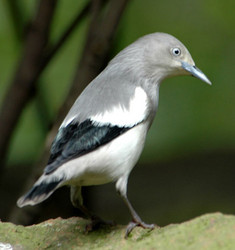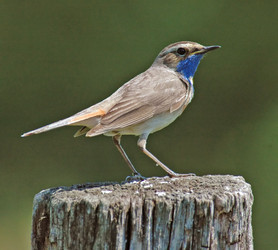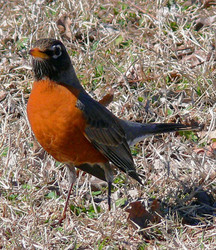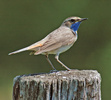Muscicapoidea
John Harshman


This tree diagram shows the relationships between several groups of organisms.
The root of the current tree connects the organisms featured in this tree to their containing group and the rest of the Tree of Life. The basal branching point in the tree represents the ancestor of the other groups in the tree. This ancestor diversified over time into several descendent subgroups, which are represented as internal nodes and terminal taxa to the right.

You can click on the root to travel down the Tree of Life all the way to the root of all Life, and you can click on the names of descendent subgroups to travel up the Tree of Life all the way to individual species.
For more information on ToL tree formatting, please see Interpreting the Tree or Classification. To learn more about phylogenetic trees, please visit our Phylogenetic Biology pages.
close boxIntroduction
Muscicapoidea is a superfamily of the order Passeriformes, erected by Sibley and Ahlquist (1990) to include the thrushes, Old World flycatchers, and their relatives. The group has a worldwide distribution.
Discussion of Phylogenetic Relationships
The most difficult question is whether Bombycillidae (waxwings, silky flycatchers, palmchat) belongs to this superfamily. No analysis has been conclusive, but several have given weak support (Sibley and Ahlquist 1990; Barker et al. 2002, 2004; Cibois and Cracraft 2004) and the combination of independent analyses seems to offer strong support. Monophyly of the rest of Muscicapoidea is clear (Sibley and Ahlquist 1990; Harshman 1994; Barker et al. 2002, 2004; Ericson and Johansson 2003; Cibois and Cracraft 2004; Voelker and Spellman 2004; Alström et al. in press).
The relationships of Hypocoliidae are uncertain. It has never been included in any formal phylogenetic analysis. Traditionally, however, it has been placed next to Bombycillidae, and that's where it appears here.
Relationships among the five families Sturnidae (starlings), Mimidae (mimic thrushes) Cinclidae (dippers), Turdidae (thrushes), and Muscicapidae (sensu stricto — Old World flycatchers) are also contentious, but a strong case can be made for the topology shown above (Sibley and Ahlquist 1990; Barker et al. 2002, 2004; Cibois and Cracraft 2004; Beresford et al. 2005; Fuchs et al. in press). An alternative arrangement in which Cinclidae is sister to the sturnid-mimid clade is supported only weakly, and in a single analysis, though the relationship between Turdidae and Muscicapidae is also supported by parsimony jackknifing (Ericson and Johansson 2003). Voelker and Spellman (2004) show a substantially different topology, in which Muscicapidae is basal, but contradictory nodes again have weak support.
Two additional genera form a polytomy with Sturnidae and Mimidae (Cibois and Cracraft 2004). Buphagus (oxpeckers) is traditionally considered part of Sturnidae. Rhabdornis is a genus of previously uncertain relationships, sometimes placed in Certhiidae or Timaliidae (Sibley and Monroe 1990).
References
Alström, P., P. G. P. Ericson, U. Olsson, and P. Sundberg. 2006. Phylogeny and classification of the avian superfamily Sylvioidea. Mol. Phylogen. Evol. 38:381-397.
Barker, F. K., G. F. Barrowclough, and J. G. Groth. 2002. A phylogenetic hypothesis for passerine birds; Taxonomic and biogeographic implications of an analysis of nuclear DNA sequence data. Proc. R. Soc. Lond. B 269:295-308.
Barker, F. K., A. Cibois, P. Schikler, J. Feinstein, and J. Cracraft. 2004. Phylogeny and diversification of the largest avian radiation. Proc. Natl. Acad. Sci. USA 101:11040-11045.
Beresford, P., F. K. Barker, P. G. Ryan, and T. M. Crowe. 2005. African endemics span the tree of songbirds (Passeri): Molecular systematics of several evolutionary "enigmas". Proc. R. Soc. Lond. B 272:849-858.
Cibois, A., and J. Cracraft. 2004. Assessing the passerine "Tapestry": Phylogenetic relationships of the Muscicapoidea inferred from nuclear DNA sequences. Mol. Phylogen. Evol. 32:264-273.
Ericson, P. G. P., and U. S. Johansson. 2003. Phylogeny of Passerida (Aves: Passeriformes) based on nuclear and mitochondrial sequence data. Mol. Phylogen. Evol. 29:126-138.
Fuchs, J., J. Fjeldså, R. C. K. Bowie, G. Voelker, and E. Pasquet. 2006. The African warbler genus Hyliota as a lost lineage in the oscine songbird tree: Molecular support for an African origin of the Passerida. Mol. Phylogen. Evol. 39:186-197.
Harshman, J. 1994. Reweaving the Tapestry: What can we learn from Sibley and Ahlquist (1990)? Auk 111:377-388.
Harshman, J. 2007. Classification and phylogeny of birds. Pages 1-35 in Reproductive biology and phylogeny of birds (B. G. M. Jamieson, ed.). Science Publishers, Inc., Enfield, NH.
Sibley, C. G., and J. A. Ahlquist. 1990. Phylogeny and classification of birds, Yale U. Press, New Haven.
Sibley, C. G., and B. L. Monroe Jr. 1990. Distribution and taxonomy of birds of the world, Yale University Press, New Haven.
Voelker, G., and G. M. Spellman. 2004. Nuclear and mitochondrial DNA evidence of polyphyly in the avian superfamily Muscicapoidea. Mol. Phylogen. Evol. 30:386-394.
Title Illustrations

| Scientific Name | Sturnus sinensis |
|---|---|
| Location | captive |
| Specimen Condition | Live Specimen |
| Source | Sturnus sinensis |
| Source Collection | Flickr |
| Image Use |
 This media file is licensed under the Creative Commons Attribution-NonCommercial-ShareAlike License - Version 2.0. This media file is licensed under the Creative Commons Attribution-NonCommercial-ShareAlike License - Version 2.0.
|
| Copyright | © 2005 Ray Cui |
| Scientific Name | Luscinia svecica |
|---|---|
| Location | Russia, Voronezh region, Usmanskij bor |
| Specimen Condition | Live Specimen |
| Sex | Male |
| Source | Bluethroat |
| Source Collection | Flickr |
| Image Use |
 This media file is licensed under the Creative Commons Attribution-NonCommercial-NoDerivs License - Version 2.0. This media file is licensed under the Creative Commons Attribution-NonCommercial-NoDerivs License - Version 2.0.
|
| Copyright | © 2006 Sergey Yeliseev |
| Scientific Name | Turdus migratorius |
|---|---|
| Location | Mississippi Delta, USA |
| Specimen Condition | Live Specimen |
| Source | American robin 2, Turdus migratorius |
| Source Collection | Flickr |
| Image Use |
 This media file is licensed under the Creative Commons Attribution-NonCommercial-NoDerivs License - Version 2.0. This media file is licensed under the Creative Commons Attribution-NonCommercial-NoDerivs License - Version 2.0.
|
| Copyright | © 2006 Jimmy Smith |
About This Page
Correspondence regarding this page should be directed to John Harshman at
Page copyright © 2006
 Page: Tree of Life
Muscicapoidea.
Authored by
John Harshman.
The TEXT of this page is licensed under the
Creative Commons Attribution-NonCommercial License - Version 3.0. Note that images and other media
featured on this page are each governed by their own license, and they may or may not be available
for reuse. Click on an image or a media link to access the media data window, which provides the
relevant licensing information. For the general terms and conditions of ToL material reuse and
redistribution, please see the Tree of Life Copyright
Policies.
Page: Tree of Life
Muscicapoidea.
Authored by
John Harshman.
The TEXT of this page is licensed under the
Creative Commons Attribution-NonCommercial License - Version 3.0. Note that images and other media
featured on this page are each governed by their own license, and they may or may not be available
for reuse. Click on an image or a media link to access the media data window, which provides the
relevant licensing information. For the general terms and conditions of ToL material reuse and
redistribution, please see the Tree of Life Copyright
Policies.
- First online 02 August 2006
- Content changed 02 August 2006
Citing this page:
Harshman, John. 2006. Muscicapoidea. Version 02 August 2006 (under construction). http://tolweb.org/Muscicapoidea/67307/2006.08.02 in The Tree of Life Web Project, http://tolweb.org/












 Go to quick links
Go to quick search
Go to navigation for this section of the ToL site
Go to detailed links for the ToL site
Go to quick links
Go to quick search
Go to navigation for this section of the ToL site
Go to detailed links for the ToL site